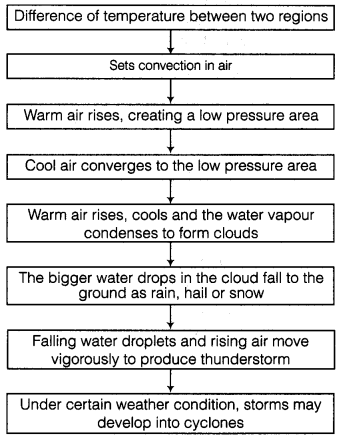WINDS, STORMS AND CYCLONES for Class 7 SCIENCE
Introduction
Jaisa ki hamare chapter ka name hai winds, storms and cyclones toh iss chapter mein hum in teeno ke baare mein padhenge. Iss chapter mein hum padhenge wind kya hoti hai, iski properties ke baare mein padhenge aur janege ki air kaise pressure exert karti hai, yeh heat karne par expand kaise karti hai, cyclone kya hota hai, tornado kya hota hai, cyclone ka structure, uska formation, etc. Yaha hum wind currents ke baare mein kuchh janege aur janege ki thunderstorms kaise cyclones ban jaate hai. Advanced technologies ki isme hamein kya help milti hai iske baare mein bhi hum padhenge.
Let's understamd about wind and take a look at some disastrous events from past
Toh sabse pehle hum jante hai ki wind kya hoti hai aur kuchh disastrous dates ko recall karte hai aur jante hai kab kya hua tha.
Wind- The moving air is called wind. Ek aisa instrument jo wind speed ko measure karne ke liye use kiya jata hai usko Anemometer kehte hai.
Ab hum jante hai ki cyclones kab aur kaha aaye.
Air Exerts Pressure
Jab bhi kisi object par koi continuous physical force lagta rehta hai usko pressure kehte hai. Air bhi different objects par sabhi directions se different pressure exert karti hai. Eg- Jab hi wind blow karti hai tab trees ki leaves, banners, flags, etc. wind ki wajah se flutter karte hai. Air ke pressure exert karne ki wajah se hi kites fly karti hai.
High Speed Winds Are Accompanied By Reduced Air Pressure
Jab bhi wind speed increase hoti hai air pressure reduce ho jata hai. Isko samajhne ke liye hum ek activity perform karenge.Activity
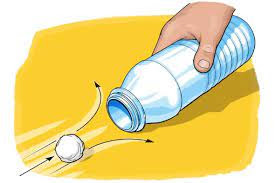
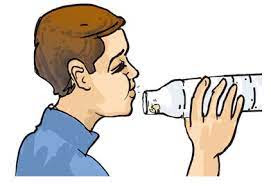
Air Expands on Heating
Hot air light weighted ho jati hai isliye hamesha upar ki taraf rise karti hai aur cold air heavy hone ki wajah se niche ki taraf aati hai. Smoke bhi isi wajah se air mein rise karti hai. Jab air ka temperature rise karta hai aur woh hot ho jati hai toh uske particles energy gain karte hai aur expand karte hai isliye heat karne par air expand karti hai. Jab hot air rise karti hai toh waha air pressure low ho jata hai aur surroundings mein se cold air uski jagah le leti hai.
Ab hum iska ek example dekhte hai.
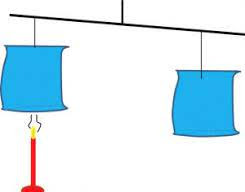
Wind Currents Are Generated Due to Uneven Heating on Earth
Movement of air ko wind kehte hai, yeh do regions ke air pressure ke difference par depend karta hai. Jaisa ki hamne padha ki atmosphere mein air high pressure region se low pressure region ki taraf move karti hai. Air pressure mein yeh difference earth ki uneven heating ki wajah se aata hai. Toh jaha air rise karti hai waha low pressure area generate ho jata hai aur jaha air sink krti hai waha high pressure area generate ho jata hai.Earth ki yeh uneven aur unequal heating do situations mein hoti hai-
Uneven heating between the equator and the poles
Earth ke equator ke paas jo regions hote hai waha sun ki maximum heat pahuchti hai isliye yeh regions jyada hot hote hai. Yaha ki air bhi heat ki wajah se warm ho jati hai. Yeh warm air rise karti hai aur iski jagah 0-30 degrees latitude belt ke regions se cooler air aa jati hai. Yeh winds north aur south se equator ki taraf chalti hai. Poles par air latitudes se 60 degrees tak cool hoti hai. Latitudes par warm air rise karti hai aur polar regions se cold air uska place le leti hai aur iss tarah se pole se warmer latitudes ki taraf wind circulation hota hai.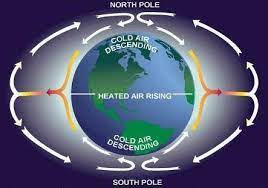
Uneven heating of land and water
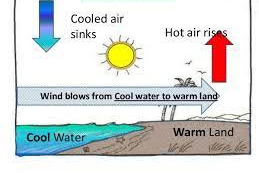
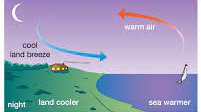
Thunderstorms And Cyclones
Thunderstorm hot, humid tropical areas mein bahut frequently develop hota hai. Lekin yeh kaise develop hota hai?
Rising temperature ki wajah se upward rising strong winds produce hoti hai, yeh winds apne saath water droplets ko bhi upar ki taraf carry karti hai jaha ja kar yeh droplets freeze ho jati hai aur wapas niche aati hai. Rising air ke sath jab yeh droplets niche aati hai toh yeh lightning aur sound create karti hai jisko hum thunderstorm kehte hai.
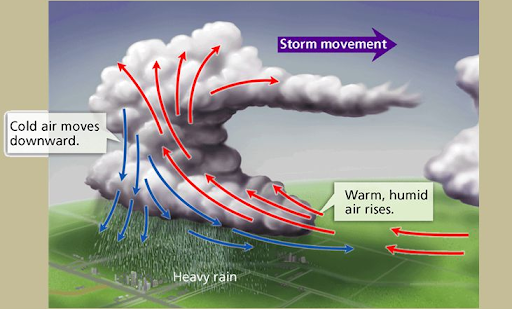
Agar ek storm ke saath lightning bhi hoti hai toh hamein kuchh cheezein avoid karni chahiye-
Ab hum padhenge cyclones kya hote hai, kaise bante hai.
Cyclone ek aisi weather condition hai jisme high-speed winds bahut low pressure central area ke around revolve karti hai. Cyclones tropical seas par develop karte hai. Yeh bahut violent storm hote hai, inki wind speed 150-250 km/h hoti hai. Iske sath bahut strong winds aur heavy rains hoti hai.
Structure of cyclone
Cyclone ka center part ek calm area hota hai aur isko hum eye of storm kehte hai. Storm eye ka diameter 10 se 30 km hota hai. Iss region mein koi clouds nahi hote aur light winds hoti hai. Iss calm aur clear eye ke around near about 150 km ka ek cloud region hota hai. Iss region mein high winds, thick clouds aur heavy rain hoti hai. Jaise-jaise hum iss region se door jaate hai waise hi wind speed decrease hoti hai.
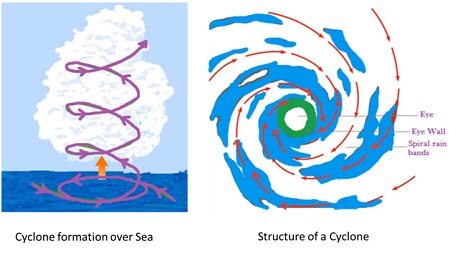
Formation of cyclones
Cyclone formation different factors par depend karta hai- temperature of the place, wind speed, direction of winds, humidity of place.
Cyclone formation ke liye heat chahiye hoti hai aur yeh heat water atmosphere se leta hai aur vapour mein convert ho jata hai. Jab yeh water vapours raindrops ki tarah wapas liquid form mein change hote hai toh yeh atmosphere mein heat release karte hai. Atmosphere mein released heat aas-paas ki air ko warm kar deti hai, warm air rise karti hai aur low pressure create karti hai. Isse jyada se jyada air storm ke center ki taraf move karti hai aur yeh cycle repeat hoti rehti hai. Yeh cycles jab end hoti hai toh ek bahut low pressure system create ho jata hai jiske around high-speed winds revolve karti hai. Issi weather condition ko hum cyclone kehte hai.
Destruction caused by cyclones
Cyclones earth par greatest storms hai aur yeh bahut destructive hote hai. Agar storm hundreds of kilometers away bhi hota hai tab bhi strong winds water ko shore ki taraf push karke storm aane ka indication deti hai. Yeh winds itne strong waves generate karta hai ki human being isko overcome nahi kar sakta. Storm eye mein jo low pressure hota hai woh center mein water surface ko lift kar sakta hai aur yeh rising water 3-12 metres tak rise karta hai. Yeh shore ki taraf move karti hui ek water wall ki tarah lagta hai. Yeh water low-lying coastal areas mein enter kar jata hai aur life aur property ka bahut loss karta hai. Cyclone ke sath jo high-speed winds aati hai yeh house, communication systems, human and aminal life, vehicles, etc. ka bahut loss karti hai. Yeh water apne sath soil ki top layer ko bhi baha kar le jata hai isliye yeh soil ko bhi less fertile bana deta hai. Cyclones ki wajah se continuous heavy rains bhi hoti hai jo iss flood situation ko aur bhi worse bana sakti hai.
Different Names of Cyclones
Cyclone ko world ke different parts men different names se jana jata hai.
Hurricane- American continent mein cyclone ko hurricane kaha jata hai.
Typhoon- Japan aur philippines mein cyclone ko typhoon kaha jata hai.
Tornadoes

Tornado ek dark funnel shaped cloud hota hai jo sky se ground tak pahuchta hai. Tornadoes cyclones ke andar hi bante hai. Yeh mostly weak hote hai. Ek violent tornado 300km/h ki speed se travel karta hai. India ki poori coastline cyclones se vulnerable hoti hai, particularly dekha jaaye to east coast jyada vulnerable hota hai aur west coast of india less vulnerable hota hai. Tornado ka diameter ek metre jitna small bhi ho sakta hai aur ek km jitna large bhi ho sakta hai. Tornado ka funnel shaped cloud low pressure ki wajah se apne base ke aas-paas present sabhi objects ko suck karke top par throw kar deta hai.
Hamein tornadoes se bachne ke liye tornado shelters prepare karne chahiye aur agar tornado shelter na ho toh hamein sabhi windows ko band kar dena chahiye aur kisi workbench ya table ke niche apne knees ko bow down karke baith jana chahiye.
Tornado shelter ek deep ya underground room hota hai jisme koi windows nahi hoti.
POINT 1
Anemometer- An anemometer is a device used for measuring wind speed and direction.
Thunderstorms- A storm with thunder and lightning and usually heavy rain.
Typhoon- A typhoon is a giant, rotating storm that brings wind, rain, and destruction.
Cyclone- A cyclone is a large scale air mass that rotates around a strong center of low atmospheric pressure.
Hurricane- A hurricane is a severe tropical storm with high winds and heavy rain.
Tornado- A violently rotating column of air touching the ground, usually attached to the base of a thunderstorm.
Monsoon winds- The monsoon winds are those winds that are created by the reversal in the atmospheric conditions over the surface of the earth.
Effective Safety Measures
Advanced Technology Has Helped
Aaj-kal technologies ki advancement ki wajah se logo ko disasters se ladne aur khud ko bachane ka time mil jata hai. Aaj-kal satellites aur radars ki wajah se expected storm se 48 hours pehle hi cyclone alerts or cyclone watch jaari kar diya jata hai aur 24 hours pehle ek cyclone warning issue kar di jati hai. Jab cyclone coast ke paas hota hai toh every hour ya fir every half hour mein message broadcast kiya jata hai. Bahut saare national aur international organisations cyclone-related disasters ko monitor karne mein help karte hai. Lekin earlier days mein aisa kuchh bhi nahi hota tha, early part of last century mein coastal residents ke paas aane waale cyclone se bachne ke liye khud ko prepare karne ke liye ek din se bhi kum time hota tha isliye aaj ke time mein hum bahut better protected hai.
SUMMARY
1. Air around us exerts pressure.
2. Air expands on heating and contracts on cooling.
3. Warm air rises up, whereas comparatively cooler air tends to sink towards the earth’s surface.
4. As warm air rises, air pressure at that place is reduced and the cooler air moves to that place.
5. The moving air is called wind.
6. Uneven heating on the earth is the main cause of wind movements.
7. Winds carrying water vapour bring rain. n High-speed winds and air pressure difference can cause cyclones.
8 It has become easier to monitor cyclones with the help of advance technology like satellites and radars.
9. Self-help is the best help. Therefore it is better to plan in advance and be ready with defence against any approaching cyclone.
10. The following flow chart will help you to understand the phenomena that lead to the formation of clouds and falling of rain and creation of storms and cyclones.
